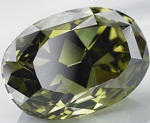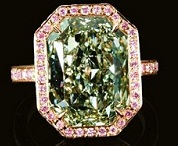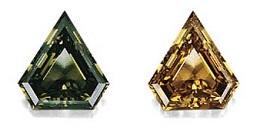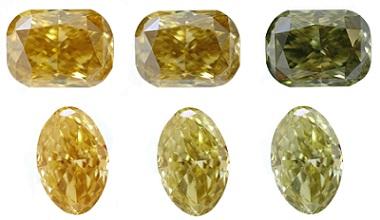Natural Chameleon Diamonds
Diamonds are a natural beauty that people have cherished throughout the history of mankind. These precious stones have always been held on such a high level because of the outstanding beauty that they reveal.
Chameleon diamonds possess one of the most unique values in the fancy coloured diamond family. As rare as all fancy coloured diamonds are, these stones are so admired because of their magnificent colour changing capabilities. They are the only natural diamonds that possess the ability to actually temporarily change colour according to their environment.Below is an image of the very same chameleon stone at different points while being heated. Notice the miraculous change of colour in the diamond.

History
One of the most well known, absolute basic diamond characteristics is the fact that a diamond’s colour will never change. Chameleon diamonds are the only ones that have the ability to temporarily change their natural colour.
The year 1943 was the first time the phenomenon of Chameleon coloured diamonds was officially recorded. Peter Kaplan, of Peter K. Kaplan Inc., noted that the colour of a diamond seemed to have change to a darker colour while on a very hot polishing wheel. The story goes that the diamond was confirmed a light yellow-green stone. The owner noticed the light yellow-green stone she had purchased turn to a dark green colour after having been stored in a jewellery box for some time. She went to return the stone for its peculiar behaviour, not knowing at the time that she had possessed a highly valuable diamond that was most likely worth a lot more than she had purchased it for.
Since that time, many diamond specialists have studied the miraculous phenomenon. Only, to this day, there is no documented cause to the affect. There have been a number of theories recorded, but none with enough science to prove the fact.
Famous Chameleon Stones

In 2007, the world’s largest Chameleon diamond was purchased by Chopard, a Swiss based luxury watch, jewellery, and Accessories Company. The diamond’s carat weight was an astonishing 31.31 carats.
Another famous piece was the 8.04ct fancy dark grey-green Chameleon coloured diamond. The piece was surrounded by pink diamonds in a pave setting and set in an 18 karat rose gold ring. Due to the size and rarity of this piece, the ring was purchased for $2,100,000.

In May 2001, a superb fancy dark gray-yellowish green chameleon diamond ring was sold at Christie’s Hong Kong auction for approximately $240,000. The stone was a 4.41 carat cut-cornered, triangular-cut stone set on a platinum mount. The image below shows this stunning piece before and after heat was applied to the stone

Fancy dark grey yellowish green Chameleon
Chameleon diamonds are such intriguing stones because of the ‘unknown’ capabilities that these jewels posses.
What is a Chameleon Diamond?
Colour is a fascinating trait that every diamond possesses. The colour of a diamond never changes regardless of the temperature or storage environment. Colour, which is the most important characteristic of fancy coloured diamonds, will always appear just as strong as it did on the original day the diamond was polished.
Needless to say, when people began noticing that certain diamond colours would change depending on the environment, this caused a pretty big stir in the industry.

Two Chameleons imaged during the heating process
There are two types of Chameleon coloured diamonds.
• ‘Classic’
• ‘Reverse’
Classic Chameleon coloured diamonds possesses two very distinct natural capabilities. Thermochromic and photochromic behaviour patterns.
Its thermochromic behaviour enables the stone to temporarily change to a darker colour when heated from 150° Celsius to 250° Celsius, for a short period of time. As the stone cools off, its colour gradually changes back to the lighter original colour. Its photochromic behaviour enables the stone to temporarily change to a darker colour when stored in a dark place for a longer period of time. When the stone is exposed to light, the lighter colour is gradually restored.
Reverse Chameleon coloured diamonds, as the name suggests, act almost exactly opposite to Classic Chameleon stones. Reverse Chameleon coloured stones have a darker stable colour. Its photochromic behaviour enables the stone to temporarily change to a lighter colour when stored in a dark place for a longer period of time. When the stone is exposed to light, the darker colour is gradually restored. Reverse Chameleon coloured stones do not have any reaction to temperature changes.
Common Chameleon Characteristics
There are a number of diamond characteristics that are common with all Chameleon coloured diamonds. Chameleon diamonds do not appear in all colour intensities. For example, they cannot be found with vivid and intense colours. Chameleon diamonds always possesses diamond fluorescence and they will always include some sort of colour combination. The combinations always include any of the following colours: Green, Yellow, Brown, and Gray. This phenomenon cannot be found in pure coloured diamonds and most often contains at least two overtone colours. However, there a number of stones that contains only one secondary hue, for example the 8.04 carat fancy dark grey- green Chameleon diamond discussed earlier in this article.
Depending on whether the stones are ‘Classic’ or ‘Reverse,’ the dominant colour can be any of the four colours mentioned. Some of the more common overtone combinations are Brownish-Yellowish, Gray-Yellowish, Grayish-Yellowish, Gray-Greenish, Brownish-Greenish, and Green-Yellow. Still, similar to all fancy coloured diamonds, no two stones are exactly alike and many other colour combinations will be found.
The Mystery behind the Cause
Chameleon diamonds have been classified as a natural colour of their own. Their behaviour cannot be replicated and there is no known treatment to cause the chameleon affect on other stones.

The colour of a diamond is created by the compound elements absorbed into the composition throughout its creation. Through the study of spectroscopy the various elements present in the composite of the diamond are defined. Even today, there is no known constant definition of elements present in Chameleon coloured diamonds.
Obviously, the large the diamond is the easier it will be identify the difference in colour variations. However, since these stones are so rare, finding a large Chameleon is not such an easy task. As a result of the rarity, Chameleon coloured diamonds are extremely sought after fancy coloured diamonds and are often sold for quite a hefty price.

